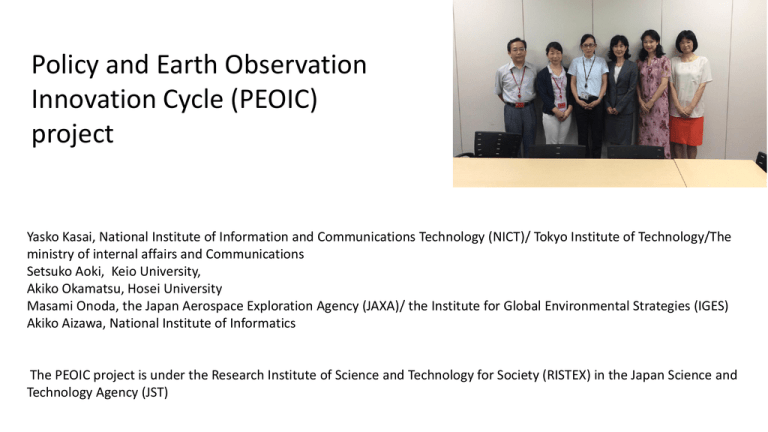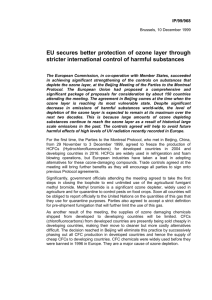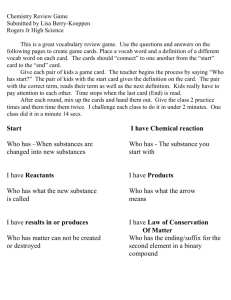present - Symbios Communications
advertisement

Policy and Earth Observation Innovation Cycle (PEOIC) project Yasko Kasai, National Institute of Information and Communications Technology (NICT)/ Tokyo Institute of Technology/The ministry of internal affairs and Communications Setsuko Aoki, Keio University, Akiko Okamatsu, Hosei University Masami Onoda, the Japan Aerospace Exploration Agency (JAXA)/ the Institute for Global Environmental Strategies (IGES) Akiko Aizawa, National Institute of Informatics The PEOIC project is under the Research Institute of Science and Technology for Society (RISTEX) in the Japan Science and Technology Agency (JST) Guidelines for the Advisory Board PEOIC is under the JST “R&D Program: Science of Science, Technology and Innovation Policy” https://www.ristex.jp/EN/examin/stipolicy/index.html The Program states that “Indeed, in science, technology and innovation (STI) policy to date, problems have been encountered not infrequently. Sometimes R&D investment has been made without adequate objective evidence. Other times, although great insights have been gained through basic research, the research outcomes have not been applied in an effective fashion so that they lead to innovations or the creation of systems to resolve challenges and advance society. Yet other times, outstanding policy ideas have been conceived, but they have not been implemented due to insufficient communication with the public. The root cause of this was the absence of clear, evidence-based methods to create STI policy. To remedy this situation, our program aims to develop methods to formulate the following kinds of policies; Policies that will lead to the resolution of real challenges by advancing the basic research and applying the research outcomes to the challenges and Policies that will promote the innovation of society by drawing on basic research. In this endeavor, it will be critical To design a multistage process from basic research, to social application of outcomes, to evaluation of that application; To develop methods for measuring the economic and social impact of R&D investment; To build an effective research framework to form policies based on objective evidence; and To ensure proper communication among policy makers, the scientific community and the public in order to promote the application of research findings in society. Objective of the Program: To contribute over the medium to long term to evidence-based policy formation in the area of STI through the following approaches; Promoting R&D projects on new analytic methodologies, models, data-systematization tools and aggregate indicators that can be used in actual policy, Increasing the number of researchers who work on this challenge in a wide range of disciplines and interdisciplinary fields, and expanding the community network through public relations and dialogue on the activities. The PEOIC Project aims at: In general: We are seeking to identify generic models, criteria or recommendations that might prompt organisations/agencies that are working on missions to consider the connection of science and technology to environmental policy in the design and concept phases. Primarily interested in the environmental policy domains … Wish to understand how science and technology (in particular EO) has (and can in the future) influence decision-makers and societal policy. Interested in specific examples. Target is to perform an assessment of the impact of satellite observations on environmental policy and use this information to propose a mission that would achieve an “innovation cycle”, whereby the assessment would feed back to new innovation for next-generation observation technology, thus contributing to global policy demand for information. For the workshop: The goal of the workshop is to propose a preliminary method/set of criteria/recommendations to provide evidence-based evaluation in order to guide the development of new missions AB members are asked to present on the relationship between EO and decision-making/societal policy in their fields of work, to identify topics for the publication and to stimulate discussion amongst the group AB members will be involved in two discussion sessions to define the goals, planned outcomes, structure, content, required inputs, and schedule for the publication. For the publication: We are aiming to address the gap in knowledge related to the impact of satellite Earth observations on enhanced societal policies. The publication will summarise, for the first time, the current state of work in the field of studies on the policy impact of satellite EO. We plan to publish a preliminary method/set of criteria/recommendations to provide evidence-based evaluation guide the development of new missions. AB members will contribute chapters based on their input to the workshop – shaped by the discussions at the workshop. Research Flow Data bases Statistical approach Policy Mining Satellite observation Inversion analysis evaluation Evaluation Policy Group Setsuko Aoki, Professor, Faculty of Policy Management, Keio University Akiko Okamatsu, Professor, Faulty of Humanity and Environment, Hosei University Hiroko Sasaki, Ocean Division, Int’l Legal Affairs Bureau, Ministry of Foreign Affairs 1 Methodology of the study 1 Goal: to find the correlation between a certain environmental policy and spacebased imagery 2 Selection of some issues likely to find a strong relationship if not correlation (1) the protection of the ozone layer legal regime to control the produce, use and transfer the ozone depleting substances (ODS) under the Vienna Convention/Montreal Protocol “the single most successful international agreement to date” (2) The Arctic region 8 1 The protection of ozone layer and satellite data 1 1985 (1988) Vienna Convention for the Protection of Ozone Layer 2 1987 (1989) Montreal Protocol on Substances that deplete the Ozone layer *4 amendments: 1990, 1992, 1997, 1999 *6 adjustments: 1990, 1992, 1995, 1997, 1999, 2007 ? 9 Path to the legal regime of the ozone layer protection year Events (scientific, social events Late 19c1930s increasing capabilities to measure the volume of the ozone around the globe and to find the relationship between the chlorofluorocarbons (CFCs), ozone layer and the health impacts 1974 Prof. Rowland & Dr. Molina: Freon gas depletes the ozone layer. An article in “Nature” 1975 The first WMO intergovernmental scientific statement :warning of the danger to the ozone layer 1977 “World Plan of Action on the Ozone Layer“ adopted in the UNEP. 1978 USA banned the use of the CFCs. TOMS sensor since November 1978 1981 Governing council of UNEP formed an ad hoc legal and technical working group to draft a Framework Convention for the Protection of the Ozone Layer. 1985 Vienna Convention for the Protection of Ozone Layer adopted. 1987 Montreal Protocol on Substances that deplete the Ozone layer Established and establishing rules to control ODS Montreal Protocol Vienna Convention (framework) Concrete obligations Developing obligations of the Montreal Protocol through Adjustments and Amendments What is provided for? *Vienna Convention (197 Parties) = to take appropriate measures --to protect human health and the environment against adverse effects resulting or likely to result from human activities which modify or are likely to modify the ozone layer. *Montreal Protocol (197 Parties) regulates the production and use of CFCs, halons, and carbon tetrachloride, which are all greenhouse gases. States parties shall totally phase out ODS in accordance with the schedule. adjustment the advancement of such time guidelines amendment adding new regulations including adding new substances to control to the Montreal Protocol Year MOP Entere d into force Contents of the Amendment 1990 MOP2 1992 Adding the following controlled substances Chlorofluorocarbon (CFCs; CFC-13, 111, 112, 211, 212, 213, 214, 215, 216, 217);Carbon tetrachloride 1,1,1-trichloroethane (methyl chloroform) ; Adding Hydrochlorofluorocarbons (HCFCs) to the transitional substances 1992 MOP4 1994 Replacing HCFCs (Hydrochlorofluorocarbons) as the controlled substances. Adding the following controlled substances; Hydrobromofluorocarbons (HBFC), Methyl bromide 1997 MOP9 1999 Banning the import and export of Methyl bromide from and to non-Parties Controlling of trade with Parties; Establishing a system for licensing the import and export of new, used, recycled and reclaimed controlled substances 1999 MOP11 2002 Adopting Hydrochlorofluorocarbons (HCFCs) to the control of production and trade Adding Bromochloromethane to the controlled substances; Banning the import and export of Bromochloromethane from and to non-Parties Providing to the Secretariat statistical data on the annual amount of the Methyl bromide Amendment year MOP Entered into force Contents of the Adjustment 1990 MOP2 1991 Adopting the severer level of production and consumption of the following controlled substances; Chlorofluorocarbons (CFCs; CFC 11, 12, 113, 114, 115); Halons (Halon 1211, 1301, 2402) 1992 MOP4 1993 Accelerating the schedule of controlling the following substances; Chlorofluorocarbons (CFCs), Halons, Other Fully Halogenated CFCs, Carbon Tetrachloride 1, 1, 1- Trichloroethane (Methyl Chloroform) 1995 MOP7 1996 Accelerating the schedule of controlling the following substances; Hydrochlorofluorocarbons (HCFC);- Methyl bromide. Adopting the schedule of the following controlled substances with respect to developing countries; Chlorofluorocarbons (CFC), Halon; -Carbon Tetrachloride; -1, 1, 1- Trichloroethane (Methyl Chloroform). Adopting the following controlled substances with respect to developing countries . Hydrobromofluorocarbons (HBFC); -Hydrochlorofluorocarbons (HCFC), Methyl bromide 1997 MOP9 1998 Accelerating the schedule of controlling Methyl bromide 1999 MOP11 2000 Adopting the schedule of the following controlled substances in order to satisfy the basic domestic needs of developing countries; Chlorofluorocarbons (CFCs), Halons, Other fully halogenated CFCs, Methyl bromide 2007 MOP19 2008 Accelerating the schedule of controlling Hydrochlorofluorocarbons (HCFCs) Adjustment Research of the the documents: Vienna Convention COP/ Montreal Protocol MOP and Ozone Research Managers (ORM), etc. Promising findings 1 Among the various reports, those by the Ozone Research Managers (ORM) best portray the role played by the satellite mission instruments. 2 From the reports available, more and more importance and effectiveness of the satellite data is recognized by increased number of countries (comparative studies of national reports, etc.) 3 Satellite data is indispensable to i) enhance the accuracy of the ground observation by comparison and ii) areas where few reliable ground observing facility exists (e.g. Mongolia) Promising finding of satellite data and the evolving control through the Montreal Protocol and its amendments/adjustments many national reports of the Ozone Research Managers (ORM) commonly state that the comparison between satellite-based observations and ground-based ones (esp. Brewer- Dobson measuring system) indispensable. (finding) Without satellite data, reliable data cannot be obtained, especially for the large-area ozone column calculation. Latest (2014) ORM meeting reports: Combination of the Satellite datasets, simulation and ground-based observation (Dobson-Brewer) should now be possible for the i) accurate calculation of the emission of the ODS and ii) Measuring the important emerging ODS replacement substances (such as HFCs) These two factors can influence the new regulations within the Montreal Protocol scheme. 2 Future consideration The arctic regime is in the midst of making for the mid-21st century. While it is in a premature phase, satellite-data could be made use of for adopting a certain policy over the other policies. A few examples of mission instruments used OCO-2; SAGE-III; AMSR-E/Aqua; AMSR-2/Aqua PALSAR/ALOS-1 (JAXA) (Private company (weather news) WNISAT-1) Data mining Group Tomohiro Sato, Yasuko Kasai, (NICT) Akiko Aizawa (NII) Objective of this Group: Quantification of relationship between Policy and Satellite Observation CEOS database Document (Policy) UNEP Meeting of the Parties (MOP) to the Montreal Protocol on Substances that Deplete the Ozone WMO/UNEP Scientific Assessments of Ozone Depletion Quantification etc First example: Ozone layer depletion Approach is: Coordinate texts that have different categories/fields/languages by Topic Analysis Ex 1: Policy document vs Paper of satellite observation EX 2: Science article vs News paper EX 3: English vs Japanese Science article (Satellite obs.) etc Example of Topic Analysis (UNEP/WMO Scientific Assessment of Ozone Depletion 2010) Latent Dirichlet Allocation (LDA) [Blei et al., 2003] Extraction of Topics that are relevant to the document “Let it be” is my favorite song. John Lennon and Paul McCartney are best The Beatles musicians. Topic ... Topic 7th: ozone simulation UV % change future model column level total projection century effect return irradiance scenario 21st Esc aerosol climate Projection of ozone in 21st century Topic 8th: ozone UV datum trend measurement total % irradiance JPL satellite model observation value solar cloud cross groundbased Clo polar radiation ... General of ozone observation Key Topics in WMO and MOP reports (Topics that include the word “ozone”) < WMO report > < MOP report > Atmospheric chemistry, Future prediction 1985 Antarctic ozone loss 1988 Chlorine species as CFC UV and ozone, Bromine species Climate change, Long-term trend Recovery, Arctic 1989 1990 1991 1992 1994 1995 1997 1998 1999 Antarctic and Arctic ozone loss 2002 Chlorine/bromine species, UV Long-term trend 2006 (We picked up important five reports.) CFC, Halon, Agreement Chlorine and bromine species Phase-out, CFC, bromine Ozone depleting substances, Multilateral Accordance, alternative, phase-out, UV “CFC” and “bromine” are the keywords Scenario of climate change in the 21C 2010 to connect WMO and MOP reports. Montreal Protocol 2014 international cooperation How to quantify: Correlation of Topics An example: Scientific paper (CiNii) vs Newspaper (Nikkei) Keywords: CFC, refrigerator Summary and future works (of Information Processing Group) Objective: Quantification of relationship between Policy and Satellite Observation Using Latent Dirichlet Allocation, Topics are extracted from the documents. “CFC” and “bromine ” are the keywords that are included in both Topics (WMO and MOP). Establishment of “quantification” of Topics that have different fields is in execution. Problems Policy is connected with “ozone” but not yet with Satellite Observation. Method of ozone measurement is not only satellite observation. There are other way of ground-based and balloon-based measurement. Future works Extract Topics of other policy documents (MOP, COP and ORM) Keep going of establishment of “quantification”




